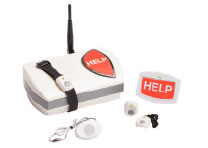MedicalAlertBuyersGuide.org is an independent review site. We may earn compensation from the providers below. Learn More
Fall Detection False Alarms in Smart Watches

The risk of falling increases as we age, and the damage sustained by a more frail body increases also. The CDC reports that one in four adults fall each year. Obviously, fall detection for seniors is a valuable element of a medical alert system. What is the state of the art in fall detection today? Are smart watches there yet?
The most common fall detection device has been the wearable pendant, connected to an alarm system and response network. Detecting a person falling to the floor was first mastered in a device that hung fairly steadily around the chest area, which meant that the whole upper torso would have to plunge to activate an alert.
As smart watches have developed to incorporate many of the medical reminder and diagnostic services provided by other devices, fall detection has been attempted, but this has given problematic early results. Moving the detection sensors from a position close to the torso, out to the end of the body’s most freely moving limb, poses great challenges for fall detection.

Apple most famously tried to master the fall for its Apple Watch, announcing for its Series 4 in late 2018 that fall detection would be among the health services included. And while the Watch brought some enormous benefits – such as its ECG function – to wearable health monitoring, fall detection was rife with problems.
A false alarm could be triggered by slapping a hand on the table for effect, or by clapping the hands together, by playing tennis or shaking sand out of a blanket, or even by chopping vegetables. One user reported false alarms simply from riding a bicycle, and NOT falling off it (which for this rider had been the purpose of the watch in the first place).
To distinguish between natural arm movements and a real fall, Apple used both a gyroscope and an accelerometer to analyze the reality – but on the ski slopes of Colorado, where falling can be a natural part of the sport, skiers placed a high demand on emergency response systems called by their watches without their knowledge.
These were early days, and Apple is now up to Series 6 of the Watch. The Watch has already demonstrated life-saving abilities in monitoring heart fibrillation. Fall detection, however, is still being worked on. Although some of the earlier mistakes have been corrected for, false alerts are still occurring.
Apple’s approach hinges on its algorithm, which attempts to learn the individual’s behavior to sort out customary movements from emergency surprises. The question some ask is whether from a legal liability point of view, the Watch will ever be able to let a possible fall be discarded as routine, without erring on the side of caution and calling it into emergency services. False positives triggered from the end of the arm may be here forever.
 One of most highly rated manufacturers of the pendant alert system with fall detection, Bay Alarm Medical (reviewed here), developed a smart watch with a number of health and medical features for seniors, but the company decided against trying to detect a fall in the watch. The company decided that the end of the arm is not the most certain place to determine if the whole body has fallen. And with seniors at risk from falling, certainty is what matters. And now recent news suggests that even Facebook is getting into the smart watch field, but the company has no plans to include fall detection.
One of most highly rated manufacturers of the pendant alert system with fall detection, Bay Alarm Medical (reviewed here), developed a smart watch with a number of health and medical features for seniors, but the company decided against trying to detect a fall in the watch. The company decided that the end of the arm is not the most certain place to determine if the whole body has fallen. And with seniors at risk from falling, certainty is what matters. And now recent news suggests that even Facebook is getting into the smart watch field, but the company has no plans to include fall detection.
The wearable alert industry is trying to get away from the pendant worn around the neck that has done most of the heavy lifting for medical alert devices in the recent decades, including for fall detection. But the question remains if all of these functions of various devices can be crammed into a smart phone or watch , which has many other operations in play, all of which drain battery life. A phone that needs to be charged every night versus a pendant with a 5-year battery may not be the best safety path for some.
Devices installed in the home may take up some of the slack when any wearable is not on the body – when sleeping or bathing for example. One company produces a radar and 3D imaging solution precisely for the bathroom to detect if a senior has fallen. Another has developed sensors in a home network that meshes unobtrusively with home décor and remains constantly monitoring for a fall.
Current and future systems for health, medical and fall monitoring exist in abundance and continue to be developed to fit the senior’s lifestyle and situation. Whether the wrist watch can ever develop the skill to detect a true fall to the ground, however, currently is not at all clear.

